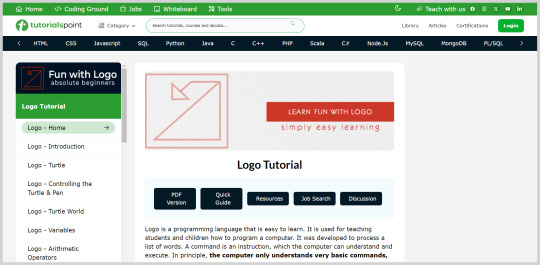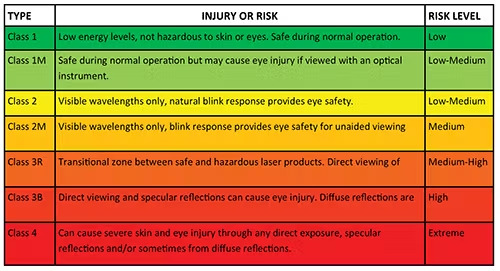#tutorialspoint
Explore tagged Tumblr posts
Text
0 notes
Text
TutorialsPoint - Logo Programming ...

Post #33: TutorialsPoint, LOGO Tutorial, Fun with Logo for absolute beginners, using MSWLogo, 2024.
#programmieren#learning#coding#programming#teaching#studying#education#turtle programming#coding for kids#turtle#turtle graphics#tutorialspoint
0 notes
Text
I give up, I cannot work on this any longer due to my mental health. My mental health is already quite low as it is and I will not add fuel to the fire by working on something I do not enjoy working on by struggling to work on this using learning methods that do not work for me, I tried to brute force through it but it instead made me feel quite sick and frustrated. So without further ado let's discuss the main topic at hand.
Is this A war crime?
No. I was wrong. The flashlight is an LED, not a laser.
Under international humanitarian laws yes laser weapons are illegal
"In international humanitarian law, the use of laser weapons is prohibited when they are specifically designed, as their sole combat function or as one of their combat functions, to cause permanent blindness to unenhanced vision, that is to the naked eye or to the eye with corrective eyesight devices."
However, assuming this is the 100,000 Lumen flashlight from IMALENT and is the IMALENT MS18 100,000 Lumens 18 CREE XHP70.2 LED Monster Flashlight. It is not a laser, LEDs are not lasers, these are two very different things, according to tutorialspoint
"LED is usually a polychromatic, i.e. it produces a broader band of wavelengths. LASER is a monochromatic source of light as it generates the light of single wavelength. LED is a non-coherent source of light, i.e. its photons are out of phase, LASER is a coherent source of light, which means its photons are in phase."
Find the images attached.

This should have been an open and closed case however I was curious and wanted to write this under the assumption it was a laser, however, this is where the struggles became apparent, so let's discuss lasers first.
There are seven classifications of lasers we will be discussing all seven here.
CLASS 1 LASERS
Not considered capable of causing an injury
CLASS 1M LASERS
Cannot cause an injury unless viewed through an optical instrument directly examples include but are not limited to telescopes and handheld magnifying glasses.
CLASS 2 LASER
A class 2 laser will emit visible light that is not hazardous for momentary/accidental optical direct viewing and is not normally considered a skin hazard.
2M CLASS LASERS
Like class 2 lasers it is not hazardous if viewed directly/accidentally optically, and is not normally considered a skin hazard, however, can cause more damage if viewed directly through an optical instrument such as but not limited to telescopes and handheld magnifying glasses.
CLASS 3R LASERS
Under the right viewing conditions, the emitted light can induce an eye injury if viewed directly but the risk is low if the exposure is momentary/accidental, these are also not normally considered a skin hazard.
CLASS 3B LASERS
Eye damage is more likely to occur if it is viewed directly or it is reflected from a mirror-like surface, this includes momentary exposure if the laser is at the upper limits for a class 3B laser, it is also more capable of causing minor skin injuries and may pose a risk of igniting flammable materials, Examples may include paper or fabric.
CLASS 4 LASERS
These are the most dangerous types of lasers and are most likely to cause optical or skin damage if exposed directly or reflected from a mirror-like surface, They remain dangerous even if the laser is a scattered light, not only the class 4 laser produce smoke and flames when interacting with certain materials that may produce a breathing hazard, in some cases it may even create plasma radiation.
Find the image attached.

In this laser list, I have listed them from least dangerous to the most dangerous with classes 3B, and 4 being the most dangerous and requiring the most control when used. Regardless of the laser classification almost all lasers can cause a distraction or impair vision so long as they emit visible light this of course needs to be under the correct circumstances.
At minimum class, 3B and 4 lasers should be only operated by authorized personnel who will use the said laser or lasers correctly, this includes establishing a laser control zone, wearing correct PPE, having warning signs posted, and using SOP (standard operating practices) and enclose the laser energy as much as possible and not wear any jewelry or any reflective materials and prevent it from going through windows and use standard precautions when using the laser or lasers in a public setting.
This is of course a very basic overview of the rules and expectations of the personnel using the laser, not only that the person or persons operating the laser are fully responsible for said laser or lasers.
Returning to this flashlight, this is an LED and again is not a laser, however, if it were the regular rules, laws, and regulations would apply to it.
Returning to my issues while working on this project, I was unable to calculate the Volts, Amps, and watts, however, I was able to figure out it takes 270 minutes or 4.5 hours to charge the flashlight using a 19-volt charger and this flashlight uses multiple batteries, not only that it does have a fan cooled system, this of course is all available on their website.
Again, I was wrong and I am sorry that I indeed was wrong about this.

when the cop pulls you over and you hit them with the unbridled power of the sun

24K notes
·
View notes
Text
Tips for Understanding Computer Databases for Homework Assignments

In today’s digital world, databases play a crucial role in managing and organizing vast amounts of information. Whether you're a student learning database concepts or working on complex assignments, understanding computer databases can be challenging. This blog will guide you through essential tips for mastering computer databases and help you complete your homework efficiently. If you're looking for computer database assistance for homework, All Assignment Experts is here to provide expert support.
What is a Computer Database?
A computer database is a structured collection of data that allows easy access, management, and updating. It is managed using a Database Management System (DBMS), which facilitates storage, retrieval, and manipulation of data. Popular database systems include MySQL, PostgreSQL, MongoDB, and Microsoft SQL Server.
Why is Understanding Databases Important for Students?
Databases are widely used in industries like banking, healthcare, and e-commerce. Students pursuing computer science, information technology, or data science must grasp database concepts to build a strong foundation for future careers. Database knowledge is essential for managing large data sets, developing applications, and performing data analysis.
Tips for Understanding Computer Databases for Homework Assignments
1. Master the Basics First
Before diving into complex queries, ensure you understand basic database concepts like:
Tables and Records: Databases store data in tables, which contain rows (records) and columns (fields).
Primary and Foreign Keys: Primary keys uniquely identify each record, while foreign keys establish relationships between tables.
Normalization: A technique to eliminate redundancy and improve database efficiency.
2. Learn SQL (Structured Query Language)
SQL is the standard language for managing databases. Some essential SQL commands you should learn include:
SELECT – Retrieve data from a database.
INSERT – Add new records to a table.
UPDATE – Modify existing records.
DELETE – Remove records from a table.
JOIN – Combine data from multiple tables.
Using online SQL playgrounds like SQL Fiddle or W3Schools can help you practice these commands effectively.
3. Use Online Resources and Tools
Numerous online platforms provide computer database assistance for homework. Websites like All Assignment Experts offer professional guidance, tutorials, and assignment help to enhance your understanding of databases. Other useful resources include:
W3Schools and TutorialsPoint for database tutorials.
YouTube channels offering step-by-step database lessons.
Interactive coding platforms like Codecademy.
4. Work on Real-Life Database Projects
Practical experience is the best way to solidify your knowledge. Try creating a small database for:
A library management system.
An online store with customer orders.
A student database with courses and grades.
This hands-on approach will help you understand real-world applications and make it easier to complete assignments.
5. Understand Database Relationships
One of the biggest challenges students face is understanding database relationships. The three main types include:
One-to-One: Each record in Table A has only one corresponding record in Table B.
One-to-Many: A record in Table A relates to multiple records in Table B.
Many-to-Many: Multiple records in Table A relate to multiple records in Table B.
Using Entity-Relationship Diagrams (ERDs) can help visualize these relationships.
6. Debug SQL Queries Effectively
If your SQL queries aren’t working as expected, try these debugging techniques:
Break queries into smaller parts and test them individually.
Use EXPLAIN to analyze how queries are executed.
Check for syntax errors and missing table relationships.
7. Seek Expert Assistance When Needed
If you find yourself struggling, don’t hesitate to seek help. All Assignment Experts offers computer database assistance for homework, providing expert solutions to your database-related queries and assignments.
8. Stay Updated with Advanced Database Technologies
The database field is constantly evolving. Explore advanced topics such as:
NoSQL Databases (MongoDB, Firebase): Used for handling unstructured data.
Big Data and Cloud Databases: Learn about databases like AWS RDS and Google BigQuery.
Data Security and Encryption: Understand how databases protect sensitive information.
Conclusion
Understanding computer databases is crucial for students handling homework assignments. By mastering basic concepts, practicing SQL, utilizing online resources, and working on real projects, you can excel in your database coursework. If you need professional guidance, All Assignment Experts provides top-notch computer database assistance for homework, ensuring you grasp key concepts and score better grades.
Start applying these tips today, and you’ll soon develop a solid understanding of databases!
#computer database assistance for homework#computer database assistance#education#homework#do your homework
1 note
·
View note
Text
Kickstart your tech career with the TutorialsPoint Python Full Stack Training Program, designed to make you job-ready with 180+ hours of content, hands-on projects, and access to coding labs. Beyond coding, we help you build confidence with soft skills training, webinars, interview preparation, and mock interviews. Plus, with 5 assured job interviews and 100% job support, you’ll have everything you need to land your dream role!
0 notes
Text
From Zero to C++ Hero: The Ultimate Beginner’s Guide to Mastering C++ If you're reading this, chances are you're ready to dive into the world of programming and have chosen C++ as your starting point. Congratulations! C++ is a powerful, versatile language used in everything from game development to high-performance computing. But where should you begin? Learning C++ can seem daunting, especially if you're a beginner. Don't worry—this guide will walk you through the best ways to learn C++, step by step, in a way that’s engaging and effective. Why Learn C++? Before we dive into the how, let’s talk about the why. C++ is one of the foundational programming languages. It’s known for its: Performance: C++ is a compiled language, making it faster than many others. Versatility: It’s used in various domains like game development, operating systems, and even financial modeling. Career Opportunities: Mastering C++ can open doors to lucrative job roles. Understanding why C++ matters will keep you motivated as you tackle its complexities. Step 1: Get Familiar with the Basics 1.1 Understand What C++ Is C++ is an object-oriented programming language. It builds on C and introduces features like classes and inheritance, which make it powerful yet complex. 1.2 Install a Compiler and IDE Before writing any code, you need the right tools: Compiler: Popular choices include GCC and Clang. IDE: Visual Studio Code, Code::Blocks, or CLion are beginner-friendly. 1.3 Learn Syntax Basics Start with: Variables and data types Loops (for, while) Conditionals (if, else if, else) Functions There are plenty of beginner tutorials and videos to guide you through these. Step 2: Use Structured Learning Resources 2.1 Books "C++ Primer" by Stanley Lippman: Great for beginners. "Accelerated C++" by Andrew Koenig: Ideal for fast learners. 2.2 Online Courses Platforms like Udemy, Coursera, and Codecademy offer interactive courses: Look for beginner-friendly courses with hands-on projects. 2.3 Tutorials and Documentation The official C++ documentation and sites like GeeksforGeeks and Tutorialspoint are excellent references. Step 3: Practice, Practice, Practice 3.1 Start with Small Projects Begin with simple projects like: A calculator A number guessing game 3.2 Participate in Coding Challenges Platforms like HackerRank, LeetCode, and Codeforces offer challenges tailored for beginners. They’re a fun way to improve problem-solving skills. 3.3 Contribute to Open Source Once you're comfortable, contributing to open-source projects is a fantastic way to gain real-world experience. Step 4: Learn Advanced Topics As you gain confidence, dive into: Object-oriented programming (OOP) Data structures and algorithms File handling Memory management and pointers Step 5: Build Real-World Projects 5.1 Why Projects Matter Building projects will solidify your skills and make your portfolio stand out. 5.2 Project Ideas Simple Games: Like Tic-Tac-Toe or Snake. Basic Software: A to-do list or budgeting app. Algorithms Visualization: Create a visual representation of sorting algorithms. Step 6: Join Communities and Stay Updated 6.1 Online Forums Participate in forums like Stack Overflow or Reddit’s r/cpp to ask questions and share knowledge. 6.2 Meetups and Conferences If possible, attend local programming meetups or C++ conferences to network with professionals. 6.3 Follow Experts Stay updated by following C++ experts and blogs for tips and best practices. Tools and Resources Round-Up Here are some of the best tools to boost your learning: Compilers and IDEs GCC Visual Studio Code Online Platforms Codecademy HackerRank Books "C++ Primer" "Accelerated C++" Final Thoughts Learning C++ is a journey, not a sprint. Start with the basics, practice consistently, and don’t hesitate to seek help when stuck.
With the right resources and determination, you’ll be writing efficient, high-performance code in no time. Happy coding!
0 notes
Text
What are the best free online resources for beginners to learn SAP?
For beginners looking to learn SAP, there are several free online resources that provide a strong foundation:
OpenSAP: SAP’s official platform offers free courses, tutorials, and certifications led by SAP experts.
SAP Community: A hub for blogs, Q&A, and discussions with SAP professionals.
YouTube Channels: Channels like Anubhav Oberoy's offer detailed tutorials and demos.
TutorialsPoint: Provides beginner-friendly SAP content with step-by-step guides.
Guru99: Free SAP tutorials covering various modules.
For comprehensive learning, Anubhav Trainings is highly recommended.

Anubhav Oberoy, a globally renowned SAP trainer, offers detailed courses with practical insights tailored for beginners and professionals. His courses, available at Anubhav Trainings, combine real-world examples and interactive sessions. Known for his expertise and global reputation, his training is ideal for those seeking career advancement in SAP.
#free online sap training#sap online training#sap abap training#sap ui5 and fiori training#sap corporate training#online sap corporate training#best corporate training#sap hana training#best sap corporate training
0 notes
Text
Top Tools for Best HTML Editors and Online HTML Editor Solutions
HTML editors are essential tools for web developers and designers. They simplify coding by offering features like syntax highlighting, auto-completion, and debugging. Whether you're a beginner or a professional, finding the best HTML editors can save time and enhance productivity. With a variety of tools available, it's essential to choose one that fits your skill level and project needs.
At our free online e-learning portal, we aim to make programming accessible to everyone. Our platform offers tutorials written in an easy-to-understand style, ideal for students and beginners. Using live examples, we guide users through learning programming languages, including HTML and CSS, making the entire process engaging and interactive.
Best HTML Editors for Developers
Visual Studio Code (VS Code): VS Code is a popular, free editor packed with features like real-time collaboration, a built-in terminal, and extensive plugins. It supports HTML, CSS, and JavaScript, making it ideal for web development.
Sublime Text: Known for its speed and efficiency, Sublime Text offers a distraction-free environment with powerful features like split editing and a command palette.
Atom: Atom is an open-source editor with a user-friendly interface. It supports HTML and other languages, allowing seamless customization through packages.
Brackets: Brackets is tailored for front-end developers. It provides a live preview feature that shows changes instantly in the browser, perfect for HTML and CSS projects.
Notepad++: Lightweight and straightforward, Notepad++ is great for beginners who need a basic editor with syntax highlighting and easy navigation.
Benefits of Using Online HTML Editor Tools
If you prefer coding without installations or want to experiment quickly, online HTML editor tools are excellent alternatives. They allow users to code directly in their browser, offering features like live previews and syntax validation.
CodePen: CodePen is a popular online platform for writing and testing HTML, CSS, and JavaScript. It offers a collaborative environment for developers to share their projects and learn from others.
JSFiddle: JSFiddle is great for testing snippets of HTML and CSS. Its simple interface and instant output make it a favorite for quick experiments.
HTML5 Editor: This tool provides a clutter-free space to write and preview HTML code. It’s perfect for beginners learning to build simple layouts.
Online HTML Editor by TutorialsPoint: This editor combines simplicity with functionality. It’s an excellent choice for beginners to practice HTML, CSS, and JavaScript without installing software.
Our e-learning platform complements these tools by teaching you how to use them effectively. With practical, step-by-step guides, we ensure you can apply what you learn in real-world projects.
Why Choose Our Platform?
We focus on simplifying programming concepts for students and beginners. By using live examples and interactive tutorials, we make learning engaging and practical. Our free tutorials cover HTML, CSS, and other programming languages, guiding you from basics to advanced topics.
Whether you're exploring the best HTML editors or diving into online HTML editor tools, having the right resources makes all the difference. Start your journey with us and unlock the potential of web development today!
0 notes
Text
MDA20009 Digital Communities (Week 4)
Prompt: 'Is blogging still relevant in the age of TikTok and Instagram?'
Blogging? I think I’ve heard of that before

Blogging is the process of creating content online and it refers to writing, photography and other media that are self-published online (Duermyer 2024). The word blog is a combined version of 'web' and 'log' and they are a type of regularly updated website that provide insight into a certain topic (Weiner 2024). In the age of TikTok and Instagram, blogging websites such as Tumblr is still relevant and popular amongst internet users as it becomes a safe space for users to share their thoughts and ideas online. Compared to social media platforms like Instagram and TikTok, blogging websites focuses more on providing content and space for niche topics where people can discuss about certain topics in the community that they’ve joined.
Domain Expansion: Infinite Scrolling

I have always been an active technology user, even back when I was in high school. I remember seeing the word “Tumblr” and "Twitter(X)" plenty of times on YouTube before, especially when YouTubers mentions it in their videos. Of course, since I was a YouTube girlie, I didn’t really bother exploring Tumblr and Twitter (X) much and was content on staying in my safe little bubble—until recently, where I keep coming back to these two microblogging platforms to indulge myself in other people's blogs.
Tumblr was created in 2007 and its whole existence was geared towards the ‘artsy’ and creative side of social media while using short entry style blogs (Baier, 2023). From arts to fanfictions, Tumblr really is the place for everyone to post anything they want—as long as they follow the website’s guideline rules, of course. The rise of Tumblr all began in 2011, with reports stating that over 10 billion blogs posts were curated on the website before eventually hitting its peak in 2014. However, Tumblr quite literally ‘fell off’ when Instagram and TikTok were beginning to gain traction from netizens and as a result, Tumblr was sadly buried underneath all the other social media platforms. RIP Tumblr, you will be missed— is what I would have said if it wasn’t for the fact that Tumblr is now gaining more attention and users almost a decade later. Tumblr didn’t just ‘die off’ but rather, it was still maintaining its popularity within niche communities.
Now, Twitter (or X, as Elon LOVES to remind us) is a social networking website that was launched in 2006 and it is undoubtedly one of the most popular social media sites today (Forsey, 2019). Twitter allows users to upload short posts known as tweets (which are basically posts with texts, pictures, videos or link uploaded in it) as well as a microblogging service that combines blogging and instant messaging in one app (TechTarget c. 1999).
I guess you can say Tumblr and Twitter (X) are quite similar with one another. The major difference that sets these two social media websites apart is that Tumblr is a microblogging social media site that focuses on creative expression and the sharing of multimedia content whereas Twitter (X) is a real-time microblogging platform that focuses on short updates and discussions (TutorialsPoint c. 2024). Although, it seems that Twitter (X) has also become a space for artists to upload their original arts and whatnot on the platform. Point is—Twitter (X) does a great job of continuing the legacy for Tumblr and these two platforms are still going strong even today.
Hold it!

Blogging still have relevancy in the age of Instagram and TikTok. Blogging can be considered as an online diary for people and writing self-published content online on websites like Tumblr or Twitter helps people to express themselves on the Internet as well as helping them find a community to join in. Internet users can interact with one another through blogs, seeing as personal blogs can expand social networks while opening dialogue between different people who share similar interests (Blogging Your Passion 2023). You’d be surprised if you knew how many people feel a sense of belonging in the communities that they joined.
Thoughts
With that being said, I do believe that blogging is still relevant in the age of Instagram and TikTok. Even Instagram got its own bootleg version of Twitter called Threads—which I have never used before because frankly, I don’t think I need to have two Twitters on my phone! While it's true that people, mostly Gen-Zs, gravitate towards short-form content that are posted on Instagram and TikTok, blogging still maintains a significant presence, particularly on platforms like Tumblr and Twitter. Both of these platforms provide opportunities for both microblogging and in-depth posts, highlighting that longer-form content still has a role to play.
(776 words)
Reference list
Baier, O 2023, Is the Tumblr era back?, Daily Collegian, viewed 21st September 2024,
<https://dailycollegian.com/2023/12/is-the-tumblr-era-back/#:~:text=Tumblr%20was%20created%20in%202007,hit%20its%20peak%20in%202014.>
Blogging Your Passion 2023, Why Do People Blog? 8 Powerful Reasons Why, Blogging Your Passion, viewed 21st September 2024,
<https://www.bloggingyourpassion.com/why-do-people-blog/>
Duermyer, R 2024, What Is Blogging?, The Balance, viewed 18th September 2024,
<https://www.thebalancemoney.com/blogging-what-is-it-1794405>
Forsey, C 2019, What is Twitter and How Does It Work?, HubSpot, viewed 22nd September 2024,
<https://blog.hubspot.com/marketing/what-is-twitter>
TechTarget c. 1999, Twitter, TechTarget, viewed 22nd September 2024,
<https://www.techtarget.com/whatis/definition/Twitter#:~:text=To%20access%20Twitter%2C%20users%20need,to%20tweets%20with%20short%20messages.>
TutorialsPoint c. 2024, Difference between Twitter and Tumblr, TutorialsPoint, viewed 22nd September 2024,
<https://www.tutorialspoint.com/difference-between-twitter-and-tumblr>
Weiner, A 2024, What is a blog? Definition, types, benefits and why you need one, WIX Blog, viewed 18th September 2024,
<https://www.wix.com/blog/what-is-a-blog>
1 note
·
View note
Text
How to Prepare for the RPSC Programmer Exam: Your Complete Guide
The Rajasthan Public Service Commission (RPSC) conducts the Programmer Exam to recruit qualified candidates for various programming positions within government departments. The RPSC Programmer Exam is highly competitive and requires dedicated preparation, a strong understanding of technical subjects, and effective time management skills. In this blog, we will provide you with a detailed preparation strategy to help you ace the exam.
Understanding the RPSC Programmer Exam Pattern
Before diving into preparation, it’s important to understand the structure of the exam. The RPSC Programmer Exam typically consists of two papers:
Paper 1: General Knowledge
Paper 2: Computer Science (Technical paper)
Paper 1 (General Knowledge):
This section tests your awareness of current events, history, geography, and the political and cultural heritage of Rajasthan. It also includes questions related to national and international current affairs.
Paper 2 (Computer Science):
This is the technical paper where you need to demonstrate your proficiency in programming languages, algorithms, operating systems, databases, computer architecture, networking, and software engineering.
Preparation Tips for RPSC Programmer Exam
Now that you know the structure, let's dive into some essential tips and strategies that will help you prepare effectively.
1. Understand the Syllabus Thoroughly
The first step in your preparation should be to download and go through the complete syllabus provided by RPSC. This will give you a clear idea of the topics you need to cover for both General Knowledge and Computer Science papers.
You can refer to this RPSC Programmer Preparation Guide 2024 for a detailed syllabus breakdown.
2. Focus on General Knowledge (GK)
To excel in the GK paper, you must stay updated with current affairs, particularly focusing on the state of Rajasthan. Here’s how to prepare:
Read Newspapers Daily: Keep yourself informed about national and international news.
Study Rajasthan-specific Books: Books like "Lakshya Rajasthan" and "Rajasthan GK" can help you with local history, culture, and geography.
Follow Reliable News Websites: Use trusted news sources to stay updated on government policies, important events, and other topics of relevance.
3. Master the Technical Subjects
The technical section of the exam focuses on your knowledge of programming and other computer science fundamentals. Some key topics to cover include:
Programming Languages: Focus on C, C++, Java, Python, and other languages mentioned in the syllabus.
Data Structures and Algorithms: Be clear about common data structures (arrays, linked lists, stacks, queues, etc.) and algorithms (sorting, searching, etc.).
Operating Systems and Databases: Study different types of operating systems, their functions, and SQL database management.
Networking: Understand networking models, protocols, IP addressing, and cybersecurity concepts.
A detailed technical preparation strategy can be found in the RPSC Programmer Preparation Guide 2024.
4. Use Standard Books and Online Resources
Here are some recommended books and resources:
For Programming: “Data Structures and Algorithms in C++” by Adam Drozdek and “The C Programming Language” by Kernighan and Ritchie.
For Operating Systems: “Operating System Concepts” by Silberschatz, Galvin, and Gagne.
For Databases: “Database System Concepts” by Silberschatz and Korth.
Online Platforms: Websites like GeeksforGeeks, TutorialsPoint, and W3Schools are great for quick references and learning programming concepts.
5. Practice Previous Year Papers
Solving previous years' RPSC Programmer exam papers will give you an insight into the type of questions asked and the difficulty level. This practice will also help you manage your time better during the actual exam.
6. Take Mock Tests
Mock tests are crucial for building exam stamina and refining your strategy. Taking regular mock tests will help you identify your weak areas and track your progress. You can find online platforms that offer mock tests for the RPSC Programmer exam.
7. Revise Regularly
With so much to cover, regular revision is key. Set aside time each week to revise the topics you’ve studied so far. Create summary notes for quick revision before the exam.
8. Stay Healthy and Manage Stress
While exam preparation is important, taking care of your mental and physical health is equally vital. Make sure you:
Get enough sleep.
Eat healthy and stay hydrated.
Take short breaks during long study sessions.
Practice stress-relief techniques like meditation or yoga.
Conclusion
Preparing for the RPSC Programmer Exam requires a well-structured approach, diligent practice, and consistent efforts. Focus on understanding the exam pattern, study according to the syllabus, and practice with previous years' papers and mock tests. For a comprehensive guide, don't forget to check out the RPSC Programmer Preparation Guide 2024, which provides additional tips and resources to help you excel.
With the right preparation strategy and determination, you can achieve success and secure a rewarding position as a programmer with the Rajasthan government. Good luck with your preparation!
0 notes
Text
1 note
·
View note
Text
Você consegue adivinhar quais são os cursos mais populares no TutorialsPoint?
Desde que os cursos on-line começaram a ser desenvolvidos, essa forma de aprendizado chamou gradualmente a atenção de milhões de pessoas em todo o mundo. A acessibilidade, a flexibilidade e a variedade de assuntos são apenas alguns dos motivos pelos quais eles se tornaram tão populares, e com razão. Agora, é inegável que, em meio à pandemia, o interesse pela educação on-line disparou, pois muitas…
0 notes
Text
A Beginner's Guide to Learning Python
Python is one of today's most popular programming languages, thanks to its simplicity, readability, and versatility. Whether you're interested in data science, web development, automation, or other tech fields, Python is a fantastic starting point. Here's a comprehensive guide to help you begin your Python learning journey. For individuals who want to work in the sector, a respectable python training in pune can give them the skills and information they need to succeed in this fast-paced atmosphere.

Grasp Basic Programming Concepts
Before diving into Python, it's beneficial to understand fundamental programming concepts. Familiarize yourself with variables, loops, conditionals, and functions. Online resources like Codecademy’s “Introduction to Programming” course or Harvard’s CS50 course provide a strong foundation.
Set Up Your Python Environment
First, install Python on your computer. Visit the official Python website to download the latest version and follow the installation instructions for your operating system.
Next, set up a development environment. Beginners often find IDEs like PyCharm or text editors like Visual Studio Code (VSCode) helpful. These tools offer features such as syntax highlighting, debugging, and code suggestions, making coding more accessible and efficient.
Master Python Syntax and Fundamentals
Begin by learning Python's syntax and core concepts. Websites like W3Schools and TutorialsPoint offer excellent introductory tutorials. Focus on these essential topics:
Variables and Data Types
Basic Operators
Control Flow (if statements, for and while loops)
Functions
Lists, Tuples, and Dictionaries
Python’s official documentation is also an invaluable resource for in-depth understanding.
Practice with Projects and Challenges
Hands-on practice is crucial for mastering Python. Start with simple projects and gradually tackle more complex ones. Websites like LeetCode, HackerRank, and Codewars offer coding challenges that help solidify your knowledge.
Here are a few beginner project ideas:
Calculator: Create a basic calculator for simple arithmetic operations.
To-Do List: Develop a command-line application to manage a to-do list.
Web Scraper: Use libraries like Beautiful Soup to scrape data from a website. Enrolling in python online training can enable individuals to unlock full potential and develop a deeper understanding of its complexities.
Explore Python Libraries and Frameworks
Python’s extensive range of libraries and frameworks is one of its greatest strengths. These tools can significantly enhance your productivity and expand your capabilities. Some essential libraries to explore include:
NumPy and Pandas: For data manipulation and analysis.
Matplotlib and Seaborn: For data visualization.
Flask and Django: For web development.
Requests: For making HTTP requests.
Beautiful Soup: For web scraping.

Join the Python Community
Engage with the Python community to enhance your learning experience. Join forums like Reddit’s r/learnpython, Stack Overflow, or the Python Discord server. These platforms offer opportunities to ask questions, share your progress, and receive feedback from experienced developers.
Stay Updated and Keep Learning
The tech field is always evolving, and Python is no exception. Stay updated with the latest developments by following Python-related blogs, subscribing to newsletters, and participating in webinars and conferences. Websites like Real Python and the Python Software Foundation blog are excellent resources for staying current.
Conclusion
Learning Python is a rewarding journey that opens numerous opportunities in the tech industry. By grasping the basics, practicing regularly, exploring libraries, and engaging with the community, you can master Python and apply it to various real-world problems. Consistency is key—keep coding, stay curious, and enjoy the process. Happy coding!
0 notes
Text
SAP HR Training Material PDF

SAP’s Human Resource (HR) module, or SAP HCM (Human Capital Management), is a cornerstone of efficient workforce management in countless businesses worldwide. To master this powerful tool, having the proper training materials is critical. PDF documents offer a convenient and accessible format for learning SAP HR, and a wealth of resources exists. Let’s dive into where to find them!
Essential SAP HR Concepts
Before exploring resources, let’s cover the fundamental SAP HR concepts you’ll be learning:
Organizational Management: Defines your company’s hierarchical structure, including departments, positions, and reporting lines.
Personnel Administration: Manages core employee data like addresses, start dates, payroll details, etc.
Time Management: Tracks employees’ working hours, absences, schedules, and overtime calculations.
Payroll: Automates the complex process of salary calculations, deductions, and tax calculations and ensures timely pay.
Recruitment: Streamlines the hiring process, from managing job postings and applications to onboarding.
Where to Find Your SAP HR Training PDFs
Official SAP Resources:
SAP Training and Certification Shop Offers official courses and often provides downloadable PDF manuals.
SAP Help Portal: A comprehensive resource with downloadable PDF guides on specific SAP HR topics.
SAP Community Forums:
SAP Community Network: Engage with other SAP users, trainers, and experts. You may find valuable PDFs shared by community members.
Online Tutorial Websites:
Tutorialspoint Provides comprehensive tutorials, often with downloadable PDFs.
UNO GEEKS: Another excellent source of PDF SAP HR learning materials.
E-Learning Platforms:
Udemy, Coursera, and LinkedIn Learning: These often have dedicated courses on SAP HR; some may include downloadable PDF materials.
Tips for Effective Learning
Start with the Basics: Ensure a strong foundation in the core concepts before diving into advanced topics.
Hands-on Practice: Using SAP HR is the best way to learn it. Find demo systems or practice environments to apply your learning.
Build a Reference Library: Organize the PDFs you find to create your knowledge base.
Stay Updated: SAP HR evolves, so ensure your materials reflect the latest updates.
The Path to SAP HR Mastery
By combining suitable PDF training materials with dedication and practice, you’ll be well on your way to becoming an SAP HR expert. Investing in excellent training resources will enhance your skills and propel you toward becoming a valuable asset to any organization using SAP.
youtube
You can find more information about SAP HR in this SAP HR Link
Conclusion:
Unogeeks is the No.1 IT Training Institute for SAP HR Training. Anyone Disagree? Please drop in a comment
You can check out our other latest blogs on SAP HR here – SAP HR Blogs
You can check out our Best In Class SAP HR Details here – SAP HR Training
———————————-
For Training inquiries:
Call/Whatsapp: +91 73960 33555
Mail us at: [email protected]
Our Website ➜ https://unogeeks.com
Follow us:
Instagram: https://www.instagram.com/unogeeks
Facebook: https://www.facebook.com/UnogeeksSoftwareTrainingInstitute
Twitter: https://twitter.com/unogeeks
0 notes
Text
SAP HR Notes Pdf

SAP HR Notes: Your Guide to Mastering SAP’s Human Resource Management
SAP Human Resources (SAP HR), or SAP Human Capital Management (SAP HCM), is a robust suite of tools designed to streamline and optimize all your HR processes. Having comprehensive notes and study materials is essential if you’re working with SAP HR or studying to become an SAP HR consultant.
Why SAP HR Notes are Important
Quick Reference: Notes condense complex SAP HR concepts into an easily digestible format, making them a tremendous on-the-job reference for troubleshooting and remembering procedures.
Knowledge Reinforcement: Taking notes while learning SAP HR modules helps solidify your understanding and allows you to revisit critical information during revisions.
Customization: Personal notes let you tailor information to your specific implementation, workflows, and any customized processes your organization might use.
Key Areas to Cover in Your SAP HR Notes
Focus on these core modules of SAP HR:
Organizational Management (OM): The foundation of SAP HR. Notes should cover creating and structuring organizational units, positions, jobs, relationships, and reporting lines.
Personnel Administration (PA): Include details on employee master data, info types (data storage units), personnel actions (hiring, terminations, promotions, etc.), and how to maintain these processes within SAP HR.
Time Management: Cover time recording methods, working time schedules, attendance/absence configuration, time evaluation, and any integration with payroll.
Payroll: Outline wage types, payroll calculation processes, integration with other SAP modules (like Finance), and country-specific payroll considerations.
Recruitment: Note down configuration for applicant management, job postings, talent pools, and the overall recruitment process.
Where to Find SAP HR Notes in PDF Format
SAP Training Materials: If you’ve taken official SAP HR courses, your training materials may be available in PDF.
Online Tutorials: Websites like Tutorialspoint offer free SAP HR tutorials, often with downloadable PDFs.
SAP Communities: Search in official SAP communities and forums. Fellow SAP HR professionals might share their study notes.
E-learning Platforms: Platforms like Udemy or Coursera might have SAP HR courses with downloadable notes.
Tips for Creating Effective SAP HR Notes
Use Clear Structure: Organize notes by modules, submodules, and processes.
Include Screenshots: Visuals make it easier to follow step-by-step instructions.
Add Customizations: Note any organization-specific configurations and how they differ from standard SAP HR setups.
Regularly Update: Keep your notes up-to-date as your SAP HR system evolves or you learn new things.
Remember: There’s no one-size-fits-all solution for SAP HR notes. The best approach is to find premade resources and personalize them with examples, explanations, and details relevant to your work.
youtube
You can find more information about SAP HR in this SAP HR Link
Conclusion:
Unogeeks is the No.1 IT Training Institute for SAP HR Training. Anyone Disagree? Please drop in a comment
You can check out our other latest blogs on SAP HR here – SAP HR Blogs
You can check out our Best In Class SAP HR Details here – SAP HR Training
———————————-
For Training inquiries:
Call/Whatsapp: +91 73960 33555
Mail us at: [email protected]
Our Website ➜ https://unogeeks.com
Follow us:
Instagram: https://www.instagram.com/unogeeks
Facebook: https://www.facebook.com/UnogeeksSoftwareTrainingInstitute
Twitter: https://twitter.com/unogeeks
0 notes
Text
SAP GRC Study Material

SAP GRC Study Materials: Your Roadmap to Compliance and Risk Management Success
SAP GRC (Governance, Risk, and Compliance) is a powerful suite of tools that helps organizations manage their risk landscape, ensure adherence to regulations, and streamline operations. Mastering SAP GRC is vital for professionals in various roles, including auditors, risk managers, and compliance officers. If you’re ready to embark on your SAP GRC journey, this blog will guide you to the best resources and study materials.
Understanding SAP GRC Modules
Before diving into study materials, it’s essential to grasp the core modules within the SAP GRC suite:
SAP Access Control: Manages user access, authorizations, and segregation of duties (SoD) risks, preventing unauthorized access.
SAP Process Control: Automates and monitors business process controls, ensuring compliance and efficiency.
SAP Risk Management: Identifies, assesses, and mitigates organizational risks, providing a centralized risk view.
Essential Study Materials
SAP Training Courses:
GRC100 – Principles of SAP Governance, Risk, and Compliance: This foundational course offers a comprehensive overview of SAP GRC concepts and functionalities.
Specialized Courses: SAP offers deep dives into specific modules, such as Access Control, Process Control, and Risk Management.
SAP Tutorialspoint:
Their SAP GRC Tutorial provides a structured guide covering key concepts and practical examples.
SAP Help Portal:
The official SAP documentation is a treasure trove of detailed information, configuration guides, and best practices.
SAP PRESS Books:
Titles like “Introducing Governance, Risk, and Compliance (GRC) in SAP S/4HANA” offer in-depth knowledge and practical scenarios. Check out for dedicated GRC publications.
Online Communities and Forums:
Engage with fellow SAP GRC professionals, ask questions, and tap into collective expertise on forums and communities.
Study Tips
Hands-on Practice: Install a demo SAP GRC system or get access to a sandbox environment for practical experience.
Focus on Fundamentals: Start with the core concepts of governance, risk, and compliance before delving into the technical aspects.
Real-world Scenarios: Relate the concepts to industry-specific regulations and use cases to solidify your understanding.
Collaboration: Join study groups or find a mentor to discuss concepts and share knowledge.
Certification Path
If you seek professional recognition, consider pursuing SAP GRC certifications. SAP offers specialized certifications for different modules, validating your expertise.
The Importance of Continuous Learning
The field of GRC and SAP technology evolves constantly. To stay ahead, commit to continuous learning through:
Webinars and Online Resources: Stay updated on best practices and industry trends.
SAP Blogs: Follow official SAP blogs and expert insights.
Embark on Your SAP GRC Journey
Mastering SAP GRC enhances your career prospects and empowers you to safeguard your organization. With suitable study materials and a dedicated approach, your SAP GRC journey can be rewarding and impactful.
youtube
You can find more information about SAP GRC in this SAP GRC Link
Conclusion:
Unogeeks is the No.1 IT Training Institute for SAP GRC Training. Anyone Disagree? Please drop in a comment
You can check out our other latest blogs on SAP GRC here – SAP GRC Blogs
You can check out our Best In Class SAP GRC Details here – SAP GRC Training
Follow & Connect with us:
———————————-
For Training inquiries:
Call/Whatsapp: +91 73960 33555
Mail us at: [email protected]
Our Website ➜ https://unogeeks.com
Follow us:
Instagram: https://www.instagram.com/unogeeks
Facebook: https://www.facebook.com/UnogeeksSoftwareTrainingInstitute
Twitter: https://twitter.com/unogeeks
#Unogeeks #training #Unogeekstraining
1 note
·
View note